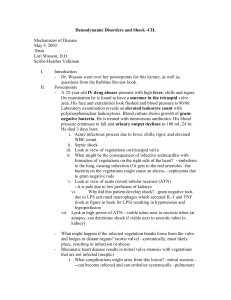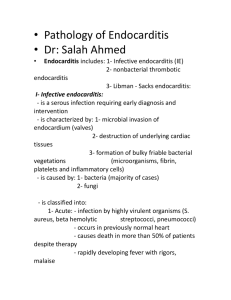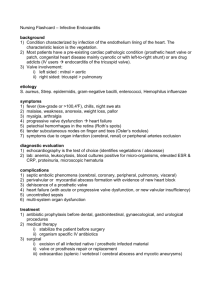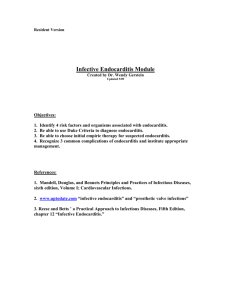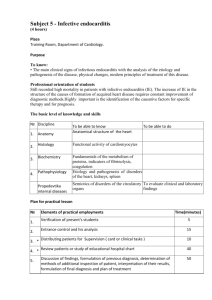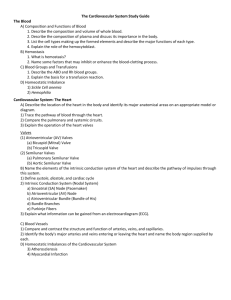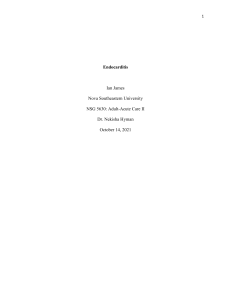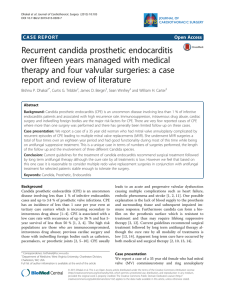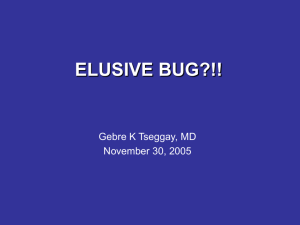2.Infective Endocarditis2015-03
advertisement
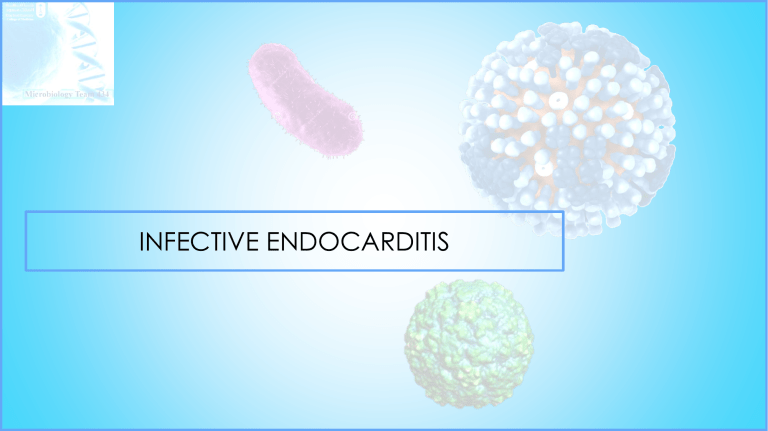
INFECTIVE ENDOCARDITIS INFECTIVE ENDOCARDITIS (IE): It is an Infection or colonization of endocardium , heart valves , congenital defects by bacteria , rickettsia , fungi. We can also definite as low grade persistent bacteraemia(bacteraemia is the presence of bacteria in the blood). 1) all affected patients were died before the discovering of antibiotics Endocarditis, irrespective of the underlying cardiac condition, is a serious, lifethreatening disease that was always fatal in the preantibiotic era1. Early recognition and management of complications of IE Advances in antimicrobial therapy Improved surgical technology have reduced the morbidity and mortality (death) of IE. MORE ABOUT INFECTIVE ENDOCARDITIS: Serious disease mortality : 30 % Damage of heart or other organs Follow dental procedures ( tooth extraction) Rheumatic heart disease Congenital heart disease Numerous comorbid factors, may complicate IE such as older age and diabetes mellitus immunosuppress ive conditions or therapy dialysis. CLASSIFICATION : CLASSIFICATION OF CLINICAL PRESENTATION: Native Valve IE Prosthetic Valve (implanting valve) IE Intravenous drug abuse (IVDA) IE Nosocomial IE (originating in a hospital) Acute Infective Endocarditis Affects normal heart valves. Rapidly destructive. Metastatic foci Commonly Staph. If not treated, usually fatal within 6 weeks. Subacute Infective Endocarditis Often affects damaged heart valves. Indolent( causing little or no pain) nature. If not treated, usually fatal by one year. ETIOLOGY: SUSCEPTIBLE PATIENT BACTEREMIA FACTORS AFFECTING SEVERITY AND OUTCOME : ▪ BACTERIAL FACTORS: Virulence, no bacteria in the blood. ▪ HOST FACTORS: - Factors increasing susceptibility Local • Congenital or rheumatic heart disease • Prosthetic heart valves • Other cardiovascular diseases • Heart surgery General • Underlying disease (Diabetes M.) Drugs • Iatrogenic: Immunosuppressant treatment, Cytotoxic agent. • Self-inflicted: Alcoholism, Injected drugs. - Protective factors: Antimicrobial chemotherapy. Dental extraction and other dental procedures Cardiac surgery ( prosthetic valves) Obstetric or gynaecologic procedures SOURCES OF INFECTION Intracardiac or intravenous catheters Intravenous medication Intravenous Drug addiction PREDISPOSING FACTORS: Cardiac lesions • Chronic rheumatic valvular disease • congenital heart disease and defects • atherosclerosis • Prosthetic valves Immediate (about one week after surgery) Delayed (about one month after surgery) Distorted shape causes stasis (stoppage of flow of a body fluid)of blood flow and settee of bacteria on the endocardium Virulent bacteria`, staph. aureus and strep. Pneumoniae can infect normal heart SYSTEMIC FACTORS • Immunosuppressive treatment • Immune defects ( disease) • Alcoholism • Iv. Drug abuse CAUSATIVE ORGANISMS: Viridians streptococci Staphylococcus aureus Staphylococcus epidermidis other • Most common cause of subacute bacterial endocarditis (SBE) • α - hemolytic • produces a polysaccharide (glucagons) which makes it sticky and so adhere to the endocardium • examples : Streptococcus mutans , Streptococcus sanguis • Acute endocarditis iv drug • Prosthetic heart valves •Streptococcus faecalis •Streptococcus pneumonia •Actinobacillus actinomycetes •Candida albicans (severe) Streptococcus faecium Brucella species Rickettsiae PATHOLOGIC CHANGES IN THE ENDOCARDIUM: fibrin platelet (thrombi) and bacterial colonies attach to heart valve Break off (detach) from the valves and become infected emboli involvement of other organs Note: the involvement of other distance organs can be: Directly : bacteremia (hematogenous) Indirectly : by inducing antigen-anti body reaction ( kidney ,brain ) immune comlex is formed (antigen anti body complex ) glomerular damage hematuria Drug addicts: often there is involvement of tricuspid, pulmonary valves of the right side of the heart. Because they take it intravenously. Increased risk to develop lung emboli and pneumonia Petechiae embolie • Nonspecific • Often located on extremities or mucous membranes Embolic manifestations of endocarditis Osler’s Nodes • More specific • Painful and erythematous nodules • Located on pulp of fingers and toes • More common in subacute IE nails CNS MORTALITY: PATHOGENESIS: - With antibiotic treatment 30% OTHER CLINICAL FEATURES: include: Mild and prolonged fever, Malaise , weight loss and weakness Changing murmurs Anaemia , leucocytosis Microscopic haematuria Splenomegaly Splinter haemorrhage Hypergammaglobulinemia Age young , elderly High mortality Virulence of organism or sever infection Presence of underlying disease Elderly Inadequate treatment poor prognosis Candida Staphylococcus Gram-negative ENDOCARDITIIS CAUSES: CONTINUOUS BACTERAEMIA: There are three clinical patterns of Bacteraemia: ● Transient: Lasts minutes to hours: following manipulation of infected tissues (Abscess, Furuncle or during a surgical procedure);instrumentation of contaminated mucosal surfaces (Dental Procedures, Cystoscopy or Sigmoidoscopy) and at the onset of bacterial Pneumonia, Arthritis, Osteomyelitis and Meningitis. ● Intermittent: Commonly occurs with undrained Abscesses. ● Continuous: Reflects an endovascular infection such as Endocarditis or Endarteritis, Suppurative Thrombophlebitis or an Infected Aneurysm. It also occurs in the first two weeks of Typhoid fever and Brucellosis. LABORATORY DIAGNOSIS: - Serial Blood Culture (2-3 sets before Antibiotic Therapy): - Aerobic. - Anaerobic. - Serological Tests: CFT ( Coxiella Burnetii ). - Sensitivity Test. - Additional Tests: - CBC, ESR and CRP, Complement levels (C3, C4, CH50). - RF. - Urinalysis. Technique For Collection Of Blood For Culture Blood for culture contaminated by normal skin flora e.g. - Staphylococcus Epidermidis. - Diphtheroids. - propionibacterium (Anaerobic Diphtheroides). - So first clean the site (Mainly Antecubital Fossa) with Alcohol 70% (leave it for 1-11/2 minutes), Chlorhexidine or Iodine. Blood culture by Automated Machines e.g. Bactec or Bact alert up to 5 days when signal Positive, the specimen is Gram Stained. So it will be reported to clinician then cultured identified and tested for Antimicrobial Susceptibility. ● Imaging - Chest x-ray : • Look for Multiple Focal Infiltrates and Calcification of Heart Valves. - ECG: • Rarely Diagnostic. • Look for evidence of Ischemia, Conduction Delay and Arrhythmias. - Echocardiography. LOCAL SPREAD OF INFECTION - Heart Failure: • Extensive Valvular Damage. - Paravalvular Abscess (30-40%): • Most common in Aortic Valve, IVDA and S. Aureus. • May extend into Adjacent Conduction Tissue causing Arrhythmias. • Higher rates of Embolization and Mortality. - Pericarditis. EMBOLIC COMPLICATIONS - Stroke. - Myocardial Infarction: • Fragments of Valvular Vegetation or Vegetation-Induced Stenosis of Coronary Ostia. - Ischemic Limbs. - Hypoxia from Pulmonary Emboli. - Abdominal Pain (Splenic or Renal Infarction). Septic Emboli - Fistulous Intracardiac Connections. Metastatic Spread Of Infection Acute S. Aureus IE with Perforation of the Aortic Valve and Aortic Valve Vegetations. Acute S. Aureus IE with Mitral Valve Ring Abscess Extending into Myocardium. - Metastatic abscess: • Kidneys, spleen, brain, soft tissues. - Meningitis and/or encephalitis. - Vertebral Osteomyelitis. - Septic Arthritis. TREATMENT - Disk Diffusion Test (Not Sufficient). - MIC, MBC. - Criteria of antibiotic: • Bactericidal. • Parenteral. • High Dose. • Prolonged. ■ Viridians streptococci: Benzyl Penicillin by I.V 4MU every 4 hrs for 4 weeks or Penicillin + Gentamicin. ■ Streptococcus faecalis: Ampicillin + Gentamicin by I.V. -Recurrence after cure is common in: Drug Addicts. Immunodeficient Patients. ANTIMICROBIAL PROPHYLAXIS (PREVENTION) - For Susceptible Patients: • Rheumatic Valvular or Congenital Heart Disease. - Before Tooth Extraction, Deep Scaling, Other Operations: Benzyl Penicillin 2M I.M 30min before 500mg Penicillin V Oral 6 hourly for 2 days afterwards. - If Patient is Allergic to Penicillin: Vancomycin or Erythromycin Lactobionate Ig I.V. 30 min before Operation. - Genitourinary Procedures: Gentamicin + Ampicillin 30min before Operation. QUIZ 1.Alcoholic-addicted-male came to ER with fever. Investigation shows he has leukocytosis and murmur. From the history he had tooth extraction before 3 weeks. What do you think the causative organism? a) Viridans Strept. b) Staph. Epidermidis c) Staph. Aureus d) Diphtheroids 2.55-old-farmer came to the hospital with fever, weight loss, petechiae. From the history he had some activity as a shepherd “taking care of sheep”. The gram stain shows –ve. What is the causative agent? a) Brucella b) Coxiella Burnetii c) Candida Albicans d) Staph. Aureus 3.40-old patient has artificial-heart valve. He had endocarditis. What is the most likely organism? a) Viridans Strept. b) Staph. Epidermidis c) Staph. Aureus d) Diphtheriods d) all of the above 5.In management of endocarditis we should measure MIC & MBC. What does MBC mean? a) Lowest concentration of antimicrobial that will inhibit the growth b) Lowest concentration of antimicrobial agent required to kill a particular bacteria 6.What is the best method to confirm diagnose of endocarditis? a) Serological test b) Sensitivity test c) CBC, ESR and CRP d) 2-3 sets of serial Blood Culture 1.A 2.B 3.B 4.D 5.B 6.D 4.In treatment course of valve inflammation due to endocarditis we should: a) Use antibiotic for long time b) Prescribe high dose c) Use bactericidal antibiotic GOOD LUCK Done by : Microbiology Team contact us: microbiology434@gmail.com Our greatest weakness lies in giving up. The most certain way to succeed is always to try just one more time. Thomas A. Edison
